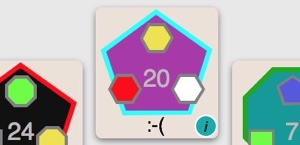Sitting in a classroom, a beginning biology student can easily come away with the impression that the Joy of Science lies in memorizing what is already known… and that historical problem solving and experimentation was about confirming what was obvious or inevitable. This describes no one I have ever worked with, and no lab I’ve ever worked in. The challenge is in delivering the excitement of figuring things out; too many labs are about taking (often stale) data.
PatternMaster (now playable via web/tablet!) lets students make discoveries about how things work using the Scientific Method. To quote the NGSS ‘Crosscutting concepts’:
1. Patterns. Observed patterns of forms and events guide organization and classification, and they prompt questions about relationships and the factors that influence them.
The term ‘problem solving’ omits some critical distinctions. Partly this arises in Math class–a ‘problem’ is anything where we recognize parallels, plug in different values to the equation, and turn the crank. In science classes, if we don’t move beyond this paradigm ‘solving problems’ can turn into performing mechanical tasks.
I want to make a distinction between ‘discovery’ elements and ‘calculation’ elements. A sudoku table is a engaging bit of calculation. Once you discover a set of algorithms for identifying the next vulnerable element, you can comfortably calculate through hundreds of specific instances of sudoku puzzle. After a few rounds, the discovery of sudoku is over; calculation reigns supreme. New ideas and insights are not required.
But exciting, cutting edge science is about recognizing an underlying order, breaking new ground, boldly going, etc. This often arises from either discerning heretofore undetected patterns, or recognizing the failure of patterns previously thought universal.
Recognizing patterns in science
Examples are everywhere. The periodicities folded into the Periodic Table of the elements were whispering to us about electrons and orbitals, and shouting about an mathematical patterns at the foundation of chemistry. The geographic distribution of sickle cell allele (HbS) prevalence and incidence of malaria provides the key clue to why the disease is common in certain populations. The planet Neptune’s very existence was inferred from perturbations in the orbit of Uranus. A cholera epidemic in England was tracked to an infected water source through John Snow’s mapping the addresses of affected individuals.
In each of these cases, the key insight was that there existed something to be discovered, and the clue was seeing the patterns in the data. A favorite quote of mine associated with phenomenon comes from Albert von Szent-Gyorgyi:
Discovery consists of seeing what everybody has seen and thinking what nobody has thought.
PatternMaster
How, then, can we give students a valid challenge in discovering patterns as part of their problem solving toolset? This is the goal of PatternMaster, in which the student seeks to discover a relationship between the colors, symbols and positions of a circular group of ‘cards’.
A PatternMaster ‘card’. Each card consists of a main shape containing a top, left, and right inner shape. Each shape is colored; the main one has both a perimeter and a fill color. There is also a central symbol, which can be either a letter or a number. The ‘frowny face’ indicator means that this card is ‘unhappy’ with some aspect of one of its neighbors.
Since the only elements in play are geometric shapes, positions in a circle, and colors, everyone is immediately ready to play. There is no complex biological system to master; the focus and thinking is all about generating and testing hypotheses. Cards can be moved within the Pattern in order to test hypotheses about who is making whom ‘happy’ and whether a given card can substitute for another within the pattern.
A little introspection reveals that the number of patterns is limited only by the cleverness of the author (your suggestions for additional Patterns welcome!). The rules vary by level; ‘Basic’ puzzles are about one-to-one relationships–e.g. the color of one element on a card is identical to the color of some element on an adjacent card. Things get interesting on the Medium and Hard puzzles (and a ‘silly’ category is in the making 🙂 ). Any relationships between the elements is fair game, so long as it is
- objective (all participants would agree on whether a given card in a given position satisfies the rule)
- able to be simply phrased
- free of conditionals (no rule will be of the form “For a green card, x, but for all other colors, y”) [this may be altered in appropriately marked challenges]
What makes PatternMaster (potentially) fun is the number of problem solving strategies available for discovery. Problem solving involves iterative application of the Scientific Approach–form a hypothesis, generate a prediction, apply a test, and modify or reject the hypothesis. I think it’s a compelling example of the Scientific Approach in action… The ‘legitimate’ problem is figuring out the Rules of the Game rather than adding details about a known system.
You might also enjoy
Petals around the Rose, a challenging and engaging ‘one time’ pattern challenge
Bongard problems, similar basics in a static 4-card format
A large collection from Simon Tatham.


Pingback: Plea for pedigrees: pedigree deduction in Introductory Biology